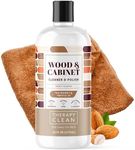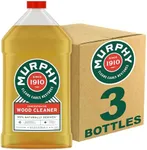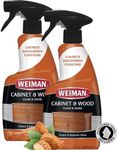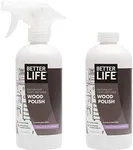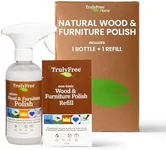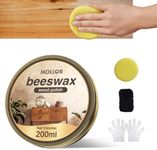Buying Guide for the Best Cleaner For Wood Cabinets
Choosing the right cleaner for your wood cabinets is essential to maintain their beauty and longevity. Wood cabinets can be sensitive to harsh chemicals, so it's important to select a cleaner that effectively removes dirt and grime without damaging the wood. Here are some key specifications to consider when selecting a cleaner for your wood cabinets, along with explanations to help you make the best choice for your needs.IngredientsThe ingredients in a wood cabinet cleaner are crucial because they determine how gentle or harsh the cleaner will be on your wood surfaces. Look for cleaners with natural or mild ingredients, such as plant-based oils or mild detergents, which are less likely to damage the wood finish. Avoid cleaners with strong chemicals like ammonia or bleach, as these can strip the wood's natural oils and cause discoloration or damage. If you have sensitive skin or allergies, also consider hypoallergenic options.
pH LevelThe pH level of a cleaner indicates its acidity or alkalinity, which can affect how it interacts with wood. A neutral pH (around 7) is ideal for wood cabinets, as it is gentle and less likely to cause damage. Acidic cleaners (pH less than 7) can etch or dull the finish, while highly alkaline cleaners (pH greater than 7) can strip the wood's natural oils. When choosing a cleaner, look for one that is specifically labeled as pH-neutral or designed for wood surfaces to ensure it is safe for your cabinets.
Application MethodThe application method of a wood cabinet cleaner can affect its ease of use and effectiveness. Cleaners come in various forms, such as sprays, wipes, or liquids. Sprays are convenient for quick and even application, while wipes are great for spot cleaning and small areas. Liquid cleaners may require dilution and can be used with a cloth or sponge for more thorough cleaning. Consider your cleaning routine and preferences when choosing the application method that works best for you.
ResidueResidue left behind by a cleaner can affect the appearance and feel of your wood cabinets. Some cleaners may leave a sticky or greasy residue, which can attract dust and dirt, making your cabinets look dirty again quickly. Look for cleaners that are labeled as 'no residue' or 'streak-free' to ensure they leave your cabinets looking clean and shiny without any unwanted film. Testing a small, inconspicuous area first can help you determine if a cleaner leaves any residue.
ScentThe scent of a wood cabinet cleaner can enhance or detract from your cleaning experience. Some cleaners have strong fragrances that can be overwhelming, while others are unscented or have a mild, pleasant scent. If you are sensitive to smells or prefer a specific fragrance, consider this when choosing a cleaner. Natural scents like lemon or lavender can leave your kitchen smelling fresh without being overpowering.
Compatibility with Wood FinishDifferent wood finishes, such as varnish, lacquer, or oil, may react differently to various cleaners. It's important to choose a cleaner that is compatible with the specific finish of your wood cabinets to avoid damage. Check the product label for information on which finishes it is safe to use on, or consult the manufacturer of your cabinets for recommendations. If you're unsure, test the cleaner on a small, hidden area first to ensure it does not harm the finish.
